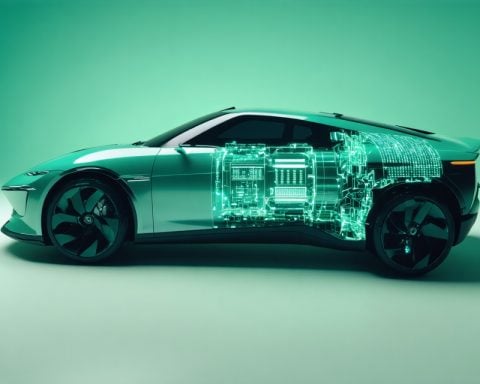- The entry of major innovators into India’s electric vehicle (EV) market generates both excitement and scrutiny.
- Market reactions reveal industry transformation rather than turmoil, shown by fluctuations in companies like Mahindra & Mahindra and Tata Motors.
- India’s diverse automotive landscape will evolve gradually; hybrid and CNG vehicles will coexist with electric ones.
- Global examples, such as China’s shift from battery brands to EV leaders, highlight the anticipated gradual success of India’s EV ecosystem.
- Challenges, such as improving charging infrastructure and cost competitiveness, must be addressed for the EV market to grow.
- Amid uncertainties, innovation is seen as crucial for advancing the auto industry in India.
When new players enter a market, especially those with innovative ideas, excitement often gives way to unease. Yet, as the electric vehicle (EV) wave brews on the horizon, it offers more of an evolutionary than revolutionary change for India’s diverse auto landscape.
The arrival of major innovators into the Indian EV space inevitably brings buzz and scrutiny. While markets react nervously—evidenced by the volatility seen by companies like Mahindra & Mahindra and Tata Motors—these movements underscore an industry in transformation, not turmoil. The presence of global electric pioneers hints at a future where the EV ecosystem may flourish, though not without its challenges.
India’s car market, rich in variety, won’t instantaneously pivot to electric vehicles alone. Picture a bustling street where hybrids hum beside CNG-fueled cars and internal combustion engines roar. This eclectic assembly reflects the ongoing journey rather than an abrupt destination shift. The burgeoning interest in electric options converges with a broader panorama of automotive technologies, ensuring a mosaic of choices rather than monolithic adoption.
This optimism echoes precedent found overseas. Consider China, where brands once associated with batteries for mobile devices pivoted astoundingly towards leading the EV pack. Their trajectory, though inspiring, underscores a universal truth: creating an EV ecosystem cannot be rushed.
As India strives to boost its EV market share beyond the current sliver, logistical and financial hurdles—from charging infrastructure to cost competitiveness—must be navigated. Amid market jitters and evolving narratives, the undercurrent remains clear: Innovation, though challenging, often bears the torch for future progress.
The Future of Electric Vehicles: Will India Embrace the EV Revolution?
How-To Steps & Life Hacks for Embracing EVs in India
1. Evaluate Vehicle Needs: Determine if an EV suits your lifestyle by assessing daily travel distance, availability of charging stations, and the type of EV (hybrid or fully electric) that meets your needs.
2. Explore Incentives: Research government subsidies and incentives for purchasing EVs in India. These can significantly reduce the upfront cost and are offered at both central and state levels.
3. Install Home Charging Solutions: If you have parking facilities, consider installing a home charging station to reduce reliance on public infrastructure.
4. Leverage Mobile Apps: Use apps that locate charging stations, manage charging times, and track EV performance.
5. Opt for Smart Chargers: Invest in smart chargers that schedule charging in off-peak times to save on electricity costs.
Real-World Use Cases
– Ride-Sharing Services: Companies like Ola and Uber are integrating EVs into their fleets, offering environmentally friendly rides.
– Public Transportation: Cities are gradually incorporating electric buses to reduce urban air pollution.
– Corporate Fleets: Businesses are adopting EVs for lower total cost of ownership and to meet sustainability goals.
Market Forecasts & Industry Trends
Recent reports predict the Indian EV market will grow by 44% annually, aiming for 30% of new vehicle sales to be electric by 2030. The government’s focus on “Atmanirbhar Bharat” (self-reliant India) is spurring local manufacturing of EVs and components.
Reviews & Comparisons
– Tata Nexon EV: Known for affordability and reliability, it’s a popular choice among Indian consumers.
– MG ZS EV: Offers a more premium experience with advanced features but at a higher price point.
– Hyundai Kona: Provides excellent range and performance, though at a higher cost than local brands.
Controversies & Limitations
– Charging Infrastructure: Insufficient public charging stations remain a significant barrier.
– Battery Manufacturing: Dependence on imported components can increase costs and limit production scalability.
– Resale Value: Concerns over the future resale value of EVs compared to traditional vehicles.
Features, Specs & Pricing
– Range: Typically between 200-400 km per charge for most EVs in India.
– Pricing: Starts from INR 10 lakhs (~$13,500 USD) for budget models to INR 25 lakhs (~$34,000 USD) for premium options.
Security & Sustainability
– Battery Recycling: Initiatives are in place to recycle lithium-ion batteries, critical for sustainability.
– Cybersecurity: Ongoing advancements focus on protecting EV communication systems from cyber threats.
Insights & Predictions
– Public Private Partnerships: Essential for developing comprehensive charging infrastructure.
– Policy Developments: Continued support will be pivotal, as seen in proposed tax benefits and infrastructure development policies.
Tutorials & Compatibility
– Charging Compatibility: Many stations support AC and DC fast charging, common across most models.
– Maintenance Tips: Follow manufacturer guidelines for battery health, and keep software updated for optimal performance.
Pros & Cons Overview
Pros:
– Environmental benefits
– Lower running costs
– Instant torque and smooth acceleration
Cons:
– Limited range and infrastructure
– Higher initial costs
– Longer refueling times compared to conventional vehicles
Actionable Recommendations
– Educate and Engage: Stay informed about EV developments via credible news sources.
– Test Drive: Experience different models through test drives to understand their features and suitability.
– Stay Updated on Policies: Government incentives and policies change frequently; staying updated can leverage greater benefits.
For a deep dive into electric vehicle advancements and infrastructure developments, exploring resources from industry leaders can be invaluable. Visit Tata Motors, Mahindra , and Hyundai for the latest insights and product offerings.
















